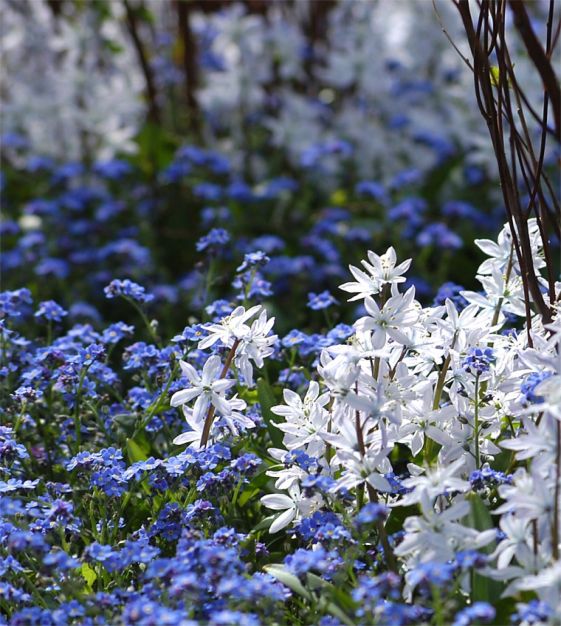-
- Discounted Collections
- Website Specials
- New for 2025!
- Tulips
- Narcissi
- Allium
- Anemone blanda
- Brodiaea
- Camassia
- Chionodoxa
- Corydalis
- Crocus
- Eranthis
- Eremurus
- Erythronium
- Fritillaria
- Galanthus
- Geranium
- Gladiolus
- Hyacinths
- Hyacinthoides
- Ipheion uniflorum
- Dutch Iris
- Rock Garden Iris
- Ixiolirion
- Leucojum aestivum
- Muscari
- Ornithogalum
- Oxalis
- Puschkinia
- Scilla
- Lilies
- Peonies
- Amaryllis
- Paperwhites
- Tender Bulbs
- Anemone Giants
- Tecolote Ranunculus
- Freesias
Scilla mischtschenkoana
Previously known as Scilla tubergeniana, this multiflowering 1931 heirloom will successively yield up to four stems, each with three to five very pale blue to white flowers with blue midveins. It matures to white. Generally referred to as Wood Squill, deer- and rodent-resistant Scilla naturalize readily in areas of light shade or dappled sunlight. You’ll need about nine bulbs per square foot. (Square footage is determined multiplying the planting site’s length times its width.) In woodland settings, you can also scatter-plant the bulbs for a more natural look. Bulb size: 6 cm/up. Full to partial sunlight. Bloom time in horticultural zone 5: March/April. Plant 5" deep and 4" to 6" apart. HZ: 4-8. Height: 5". (Scilla are also good for forcing: pot them up in mid-October, precool them at a consistent, dark 38° to 45°F for six to eight weeks with moderate watering. Bring them into the house~they will bloom about two to four weeks later.)
Scilla are The Art & Soul of Spring.
Scilla Horticultural Tips Stinze Plantings
- Information
Scilla
For decades, perhaps generations, Hyacinthoides and Scilla have been classified and reclassified together as Scilla or Endymion, or apart, as they are today, as Hyacinthoides and Scilla. They are deer- and rodent-resistant, prefer a bit of light shade and naturalize readily in both woodland settings and display gardens, becoming increasingly more substantial and prolific over time. Economical for large woodland drifts or garden border swaths, you’ll be amazed over the transformative impact that these little bulbs have over time.
Scilla are The Art & Soul of Spring.
Scilla Horticultural Tips Stinze Plantings
For decades, perhaps generations, Hyacinthoides and Scilla have been classified and reclassified together as Scilla or Endymion, or apart, as they are today, as Hyacinthoides and Scilla. They are deer- and rodent-resistant, prefer a bit of light shade and naturalize readily in both woodland settings and display gardens, becoming increasingly more substantial and prolific over time. Economical for large woodland drifts or garden border swaths, you’ll be amazed over the transformative impact that these little bulbs have over time.
Scilla are The Art & Soul of Spring.
Scilla Horticultural Tips Stinze Plantings
Scilla
For decades, perhaps generations, Hyacinthoides and Scilla have been classified and reclassified together as Scilla or Endymion, or apart, as they are today, as Hyacinthoides and Scilla. They are deer- and rodent-resistant, prefer a bit of light shade and naturalize readily in both woodland settings and display gardens, becoming increasingly more substantial and prolific over time. Economical for large woodland drifts or garden border swaths, you’ll be amazed over the transformative impact that these little bulbs have over time.
Scilla are The Art & Soul of Spring.
Scilla Horticultural Tips Stinze Plantings
For decades, perhaps generations, Hyacinthoides and Scilla have been classified and reclassified together as Scilla or Endymion, or apart, as they are today, as Hyacinthoides and Scilla. They are deer- and rodent-resistant, prefer a bit of light shade and naturalize readily in both woodland settings and display gardens, becoming increasingly more substantial and prolific over time. Economical for large woodland drifts or garden border swaths, you’ll be amazed over the transformative impact that these little bulbs have over time.
Scilla are The Art & Soul of Spring.
Scilla Horticultural Tips Stinze Plantings





